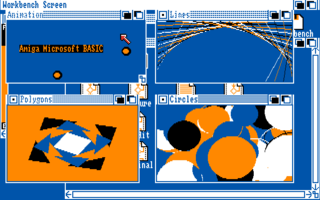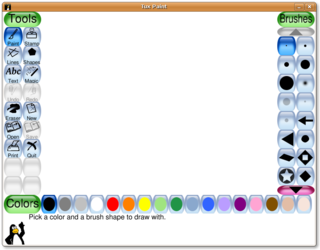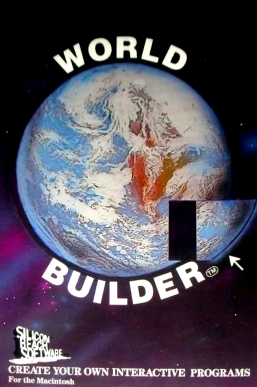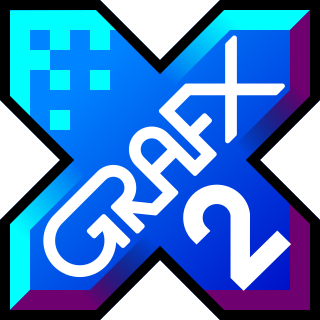
Vector graphics are a form of computer graphics in which visual images are created directly from geometric shapes defined on a Cartesian plane, such as points, lines, curves and polygons. The associated mechanisms may include vector display and printing hardware, vector data models and file formats, as well as the software based on these data models. Vector graphics are an alternative to raster or bitmap graphics, with each having advantages and disadvantages in specific situations.
A blitter is a circuit, sometimes as a coprocessor or a logic block on a microprocessor, dedicated to the rapid movement and modification of data within a computer's memory. A blitter can copy large quantities of data from one memory area to another relatively quickly, and in parallel with the CPU, while freeing up the CPU's more complex capabilities for other operations. A typical use for a blitter is the movement of a bitmap, such as windows and icons in a graphical user interface or images and backgrounds in a 2D video game. The name comes from the bit blit operation of the 1973 Xerox Alto, which stands for bit-block transfer. A blit operation is more than a memory copy, because it can involve data that's not byte aligned, handling transparent pixels, and various ways of combining the source and destination data.

MacPaint is a raster graphics editor developed by Apple Computer and released with the original Macintosh personal computer on January 24, 1984. It was sold separately for US$195 with its word processing counterpart, MacWrite. MacPaint was notable because it could generate graphics that could be used by other applications. It taught consumers what a graphics-based system could do by using the mouse, the clipboard, and QuickDraw picture language. Pictures could be cut from MacPaint and pasted into MacWrite documents.

Deluxe Paint, often referred to as DPaint, is a bitmap graphics editor created by Dan Silva for Electronic Arts and published for the then-new Amiga 1000 in November 1985. A series of updated versions followed, some of which were ported to other platforms. An MS-DOS release with support for the 256 color VGA standard became popular for creating pixel graphics in video games in the 1990s.

Amiga Basic is an interpreted implementation of the BASIC programming language for the Amiga. It was designed and written by Microsoft. Amiga Basic shipped with AmigaOS versions 1.1 to 1.3. It succeeded MetaComCo's ABasiC included in AmigaOS 1.0 and 1.1 and was superseded by ARexx, a REXX-style scripting language, from AmigaOS version 2.0 onwards.
In computer graphics, graphics software refers to a program or collection of programs that enable a person to manipulate images or models visually on a computer.
ARexx is a Rexx interpreter for Amiga, written in 1987 by William S. Hawes, with a number of Amiga-specific features beyond standard Rexx. An ARexx script can communicate with software that implements an ARexx port. An Amiga application can define a set of commands and functions for ARexx to address, thus making the capabilities of the software available to an ARexx script. Several applications support running an ARexx script as a macro.

Tux Paint is a free and open source raster graphics editor geared towards young children. The project was started in 2002 by Bill Kendrick who continues to maintain and improve it, with help from numerous volunteers. Tux Paint is seen by many as a free software alternative to Kid Pix, a similar proprietary educational software product.

The Faery Tale Adventure is a 1987 action role-playing video game designed by David Joiner and published by MicroIllusions for the Amiga, and later ported to the Commodore 64, MS-DOS, and Sega Genesis. The MS-DOS version is titled The Faery Tale Adventure: Book I. Microillusions also released a "Book 1" version for the Amiga which was going to be the start of a series of games, according to Talin, but bankruptcy prevented it. The initial version was produced for the Amiga 1000 and featured the largest game world to that date. A sequel, Faery Tale Adventure II: Halls of the Dead, was released in 1997.
Brilliance is a bitmap graphics editor for the Amiga computer, published by Digital Creations in 1993. Although marketed as a single package, Brilliance in reality consisted of two separate applications. One was a palette-based package also named Brilliance. The other was a true-color package called TrueBrilliance.

World Builder is a game creation system for point-and-click text-and-graphics adventure games. It was released for Macintosh in 1986 by Silicon Beach Software and had already been used for creating Enchanted Scepters in 1984. On August 7, 1995, developer William C. Appleton released World Builder as freeware.
Amiga software is computer software engineered to run on the Amiga personal computer. Amiga software covers many applications, including productivity, digital art, games, commercial, freeware and hobbyist products. The market was active in the late 1980s and early 1990s but then dwindled. Most Amiga products were originally created directly for the Amiga computer, and were not ported from other platforms.

SuperPaint is a graphics program capable of both bitmap painting and vector drawing. SuperPaint was one of the first programs of its kind, combining the features of MacPaint and MacDraw while adding many new features of its own.
Project Dogwaffle is a raster graphics editor with animation capabilities. It was written by Dan Ritchie, runs on Microsoft Windows, and has both freeware and commercial versions. The commercial version, PD Pro Digital Painter, is updated frequently while the most recent freeware version is Project Dogwaffle 1.2, released in 2004. The free version is fully functional, lacking only the advanced layer and scripting tools in version 2 of the commercial product.
Photogenics is raster graphic editing software produced by Idruna Software.
MicroIllusions was a computer game developer and publisher of the home computer era. Based in Granada Hills, California, the company was a strong supporter of the Amiga and typically released titles on that platform before porting it to others.
Cricket Paint was a second generation 1-bit painting software program for the Apple Macintosh by Cricket Software. It followed MacPaint and was a competitor to Silicon Beach Software's SuperPaint. Like SuperPaint it was an early attempt to combine the separate graphic methods of bitmap and vector graphics.
Cricket Software already had a vector-only package called CricketDraw. The way it achieved this dualism was with a feature called WetPaint. This allowed the user to draw vector graphics and modify them in an object-oriented way like in Apple's MacDraw, for example, changing the size, stroke and fill. When satisfied, the user could click outside the object and Cricket Paint would convert the vector graphic into a bitmap and place it on the canvas, in a destructive edit. This package had some extra tools not found in MacPaint or MacDraw, such as the Spiral and Starburst, which drew radial lines.
This article deals with productivity software created for the Amiga line of computers and covers the AmigaOS operating system and its derivatives AROS and MorphOS. It is a split of the main article, Amiga software.

GrafX2 is a bitmap graphics editor inspired by the Amiga programs Deluxe Paint and Brilliance. It is free software and distributed under the GPL-2.0-only license.

Dr. Halo is a raster graphics editor developed by Media Cybernetics and released for computers running MS-DOS. It was among the first graphics editors available for MS-DOS with its initial release in 1984. Media Cybernetics boasted about three million users of Dr. Halo between 1984 and 1993.









